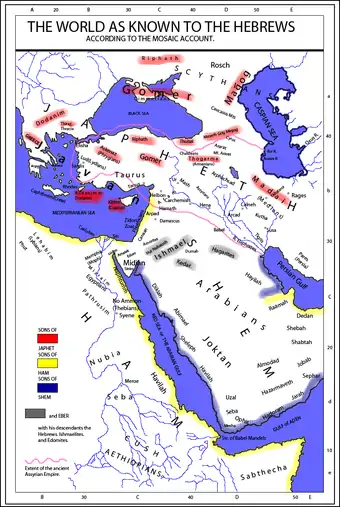Pathros
Pathros (Hebrew: פַּתְרוֹס, Pathrôs; Greek: Φαθωρῆς, Phathōrēs; Koine Greek: Παθούρης, Pathourēs) refers to Upper Egypt, primarily the Thebaid where it extended from Elephantine fort to modern Asyut north of Thebes.[1] Gardiner argues it extended to the north no farther than Abydos.[2] It is mentioned in the Hebrew Bible in Jeremiah 44:1 and 15; Isaiah 11:11; and Ezekiel 29:14, 30:14. It is the homeland of the Pathrusim.

A map of the Generations of Noah, placing the "Pathrusim" in Upper Egypt.
The name is a loan from Egyptian pꜣ tꜣ-rsy "the southern land" (e.g., pBritish Museum EA 10375, line 16; cf. Sahidic Coptic ⲡⲁⲧⲟⲩⲣⲏⲥ and Bohairic Coptic ⲡⲁⲑⲟⲩⲣⲏⲥ.[3][4])
| tp-rsy in hieroglyphs |
|---|
As in Hebrew and Greek, the term was used in Akkadian by the Assyrians as patúrisi, for example in the Annals of Esarhaddon.[5]
See also
References
- Van Den Boorn, G.P.F (2014). The Duties of the Vizier. Routledge. ISBN 9781136881787., p. 213
- Gardiner, Alan H. (1957). "The Reading of the Geographical Term [tp-rsy]". The Journal of Egyptian Archaeology. Sage Publications, Ltd. 43: 4. doi:10.1177/030751335704300104. S2CID 192379697.
- Crum, Walter Ewing (1939). A Coptic dictionary. Oxford: Clarendon Press. p. 300.
- Westendorf, Wolfhart (1965–1977). Koptisches Handwörterbuch. Heidelberg: Carl Winter - Universitätsverlag. p. 166.
- "Esarhaddon 060". The Royal Inscriptions of the Neo-Assyrian Period. Open Richly Annotated Cuneiform Corpus. Retrieved 15 November 2014. See line o 8'.
This article is issued from Wikipedia. The text is licensed under Creative Commons - Attribution - Sharealike. Additional terms may apply for the media files.